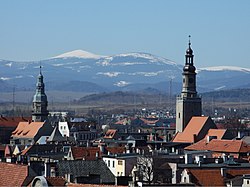Kamienna Góra
Kamienna Góra | |
|---|---|
 Kamienna Góra with Karkonosze mountain range | |
| Coordinates: 50°47′N 16°02′E / 50.783°N 16.033°E | |
| Country | |
| Voivodeship | Lower Silesian |
| County | Kamienna Góra |
| Gmina | Kamienna Góra (urban gmina) |
| Government | |
| • Mayor | Krzysztof Świątek |
| Area | |
| • Total | 17.97 km2 (6.94 sq mi) |
| Population (2006) | |
| • Total | 21,440 |
| • Density | 1,200/km2 (3,100/sq mi) |
| Time zone | UTC+1 (CET) |
| • Summer (DST) | UTC+2 (CEST) |
| Postal code | 58-400 |
| Car plates | DKA |
| Website | http://www.kamiennagora.pl |
Kamienna Góra [kaˈmʲɛnːa ˈɡura] (Template:Lang-de, Template:Lang-cs, Kamenná Hora) is a town in south-western Poland with 21,440 inhabitants (2006). It is the seat of Kamienna Góra County, and also of the rural district called Gmina Kamienna Góra, although it is not part of the territory of the latter (the town forms a separate urban gmina).
Kamienna Góra on the Bóbr river is situated in Lower Silesian Voivodeship (from 1975–1998 it was in the former Jelenia Góra Voivodeship) between the Stone Mountains and the Rudawy Janowickie at the old trade route from Silesia to Prague, today part of the National Road No. 5. It lies approximately 95 kilometres (59 miles) south-west of the regional capital Wrocław.
History

In 1254 the Piast Duke Bolesław II the Bald of Legnica gave the area to the Benedictine monastery of Opatovice (in eastern Bohemia), who already had established Grüssau Abbey at nearby Krzeszów. When the abbey passed to the Cistercians in 1289, Kamienna Góra was acquired by Duke Bolko I the Strict of Świdnica, who extended it as a stronghold against Kingdom of Bohemia. It received town privileges by Duke Bolko II the Small in 1334. Nevertheless, the duchy fell to the Bohemian crown with Bolko's death in 1368. It burnt down during the 1426 Hussite campaign to Silesia.
After Frederick II of Prussia had conquered Silesia in 1742, his fierce opponent Maria Theresa of Austria once again struck back in the course of the Seven Years' War. In 1760 Austrian troops under the command of field marshal Laudon invaded the province and on June 23 defeated a Prussian corps under Heinrich August de la Motte Fouqué at the Battle of Landeshut.
After World War II the region was placed under Polish administration by the Potsdam Agreement under territorial changes demanded by the Soviet Union. Most Germans fled or were expelled and replaced with Poles expelled from the Polish areas annexed by the Soviet Union.
Notable people
- Walter Arndt (1891–1944), zoologist
- Gosia Dobrowolska (born 1958), actress
- Rudolf Hamburger (1903–1980), architect and spy
- Viktor Hamburger (1900–2001), biologist
- Carl Gotthard Langhans (1732–1808), architect, designer of the Brandenburg Gate
International relations
Twin towns — Sister cities
Kamienna Góra is twinned with:
Gallery
-
Kamienna Góra seen from Zamkowa Hill.
-
Town hall building
-
Station building
-
Hospital
-
Museum
-
Church of the Sacred Heart
-
Church St Peter und Paul
-
Court
-
Castle ruins
-
Church of Our Lady of the Rosary
-
Bridge over the river Bóbr

















